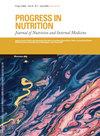Polyphenols analysed by UHPLC-ESI-MS/MS and antioxidant activities of molasses, acorn and leaves of oak (Quercus robur subsp. pedunculiflora)
4区 医学
Q4 Agricultural and Biological Sciences
引用次数: 20
Abstract
Objectives: The leaves of oak trees have been boiled in water and the extracts have been evaporated to produce oak molasses. Colloidal precipitants have been widely used as dietary molasses since have very effective antiseptic functions as alternative medicine for ages in some parts of the world. Present study aimed to investigate the biological activities of oak products for elucidating the scientific basis of alternative medicine. Thus, antioxidant activities of ethanol and water extracts of acorn, leaves and molasses of oak trees (Quercus robur subsp. pedunculiflora) were evaluated. Results: We determined antioxidant activities of extracts by different in vitro methods including DPPH free radical scavenging, ABTS•+ radical scavenging, total antioxidant activity determination by ferric thiocyanate method, reducing power by FRAP methods, separately. The results were compared with BHA, BHT and ascorbic acid as standard antioxidant compounds. The acorn seed extract, which presented the highest antioxidant potential, was the most effective scavenger against DPPH free radical. Also, phenolic compounds of the molasses were identified by UHPLC-ESI-MS/MS. The highest phenolic compound was quinic acid (4556 ± 219 ppb). Conclusion: Acorns and leaves of oak trees (Quercus robur subsp. pedunculiflora), as well as traditional oak molasses” have high antioxidant potential for the food industry as a food ingredient to produce functional food products.UHPLC-ESI-MS/MS法分析了橡树糖蜜、橡实和叶片中多酚类物质的抗氧化活性。pedunculiflora)
目的:将橡树的叶子在水中煮沸,并将其提取物蒸发以产生橡树糖蜜。胶体沉淀剂作为膳食糖蜜已被广泛使用,因为它具有非常有效的防腐功能,在世界上一些地区作为替代药物已使用多年。本研究旨在研究橡树产品的生物活性,为阐明替代医学的科学依据。因此,研究了橡子、橡树叶和橡树糖蜜的乙醇和水提取物的抗氧化活性。花序梗)进行评价。结果:分别采用DPPH自由基清除法、ABTS•+自由基清除法、硫氰酸铁法测定总抗氧化活性、FRAP法测定还原力等体外抗氧化活性。结果与BHA、BHT和抗坏血酸作为标准抗氧化化合物进行了比较。橡子提取物抗氧化能力最强,对DPPH自由基的清除效果最好。并用UHPLC-ESI-MS/MS对糖蜜中的酚类化合物进行了鉴定。酚类化合物含量最高的是奎宁酸(4556±219 ppb)。结论:柞树(Quercus robur subsp.)的橡子和叶片。在食品工业中,作为一种生产功能性食品的食品配料,它们具有很高的抗氧化潜力。
本文章由计算机程序翻译,如有差异,请以英文原文为准。
求助全文
约1分钟内获得全文
求助全文
来源期刊

Progress in Nutrition
医学-营养学
CiteScore
1.40
自引率
0.00%
发文量
0
审稿时长
>12 weeks
期刊介绍:
Progress in Nutrition was founded in 1999 as an independent magazine, a multidisciplinary approach, dedicated to issues of nutrition and metabolism.
 求助内容:
求助内容: 应助结果提醒方式:
应助结果提醒方式:


